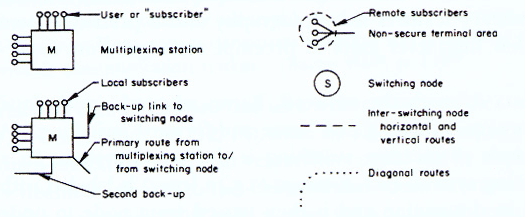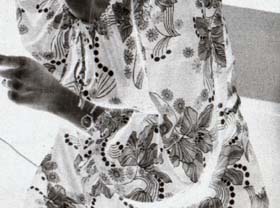|
If you are to read a book called Inventing the Internet by Janet Abbate, make careful note of the sincerely uninteresting diagram labeled (Fig. 1.1) that appears early in the first chapter. It is: “Paul Baran's design featuring highly connected switching nodes. Source: Baran 1964a. Volume VIII”, the initial diagram for the military ARPANET network, predecessor to the Internet. Depicted in the diagram are rows of people seated in what looks to be an amusement park ride marked M, with another group of people sticking out the side. “Switching nodes”, “Inter-switching nodes”, “Remote subscribers”, and “Non-secure terminal areas” form an order of lines, strokes, dashes, dots.
Flick forward to page 33 and the picture you find is a photograph of a lady who is introducing us to the first computer terminal that could access a network, the Mark I. Her dress and the diagram form a remarkable comparison. The lines and nodes representing the military network and its users are mirrored in the lines and nodes of petals and stamen as they connect in a floral pattern of a computer network, across her. The diagram has somehow resurfaced in a contemporised pattern of the lady's dress.
We have lived around such floral patterns. In wallpapers, seat covers, architectural decoration; a Prophetic diagram that has lain benign and waiting for years. Encounter at the same time as this a beautiful book that explores the structures of the living and inanimate worlds, and read these at the same time. Philip Ball's The Self-Made Tapestry knits patterns together.
Of a zebra's stripes, bubbles in foam, silt in hot water and honeycombs, spinning out that if two patterns are found to be similar, a shared force is at work. Hidden forces in composition.
Images and quotes from Janet Abbate's Inventing the Internet, 2000
|
|||
| Get Interlayer code | Go back to Interlayers for the Internet | |||





